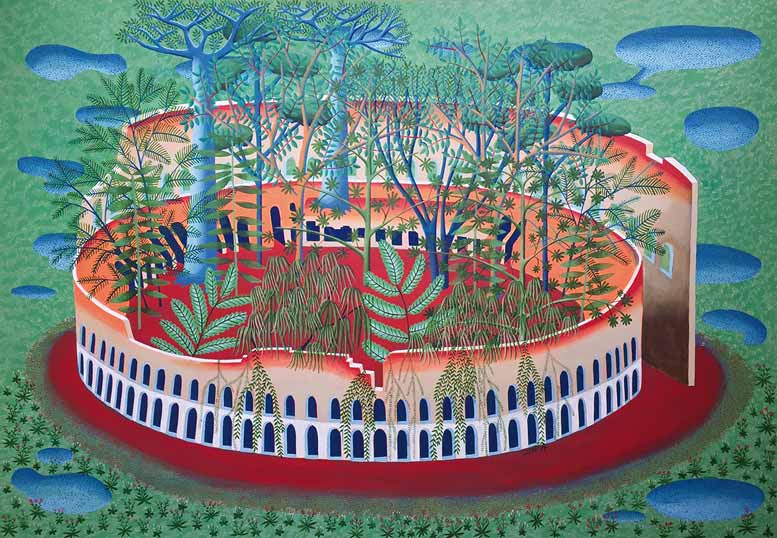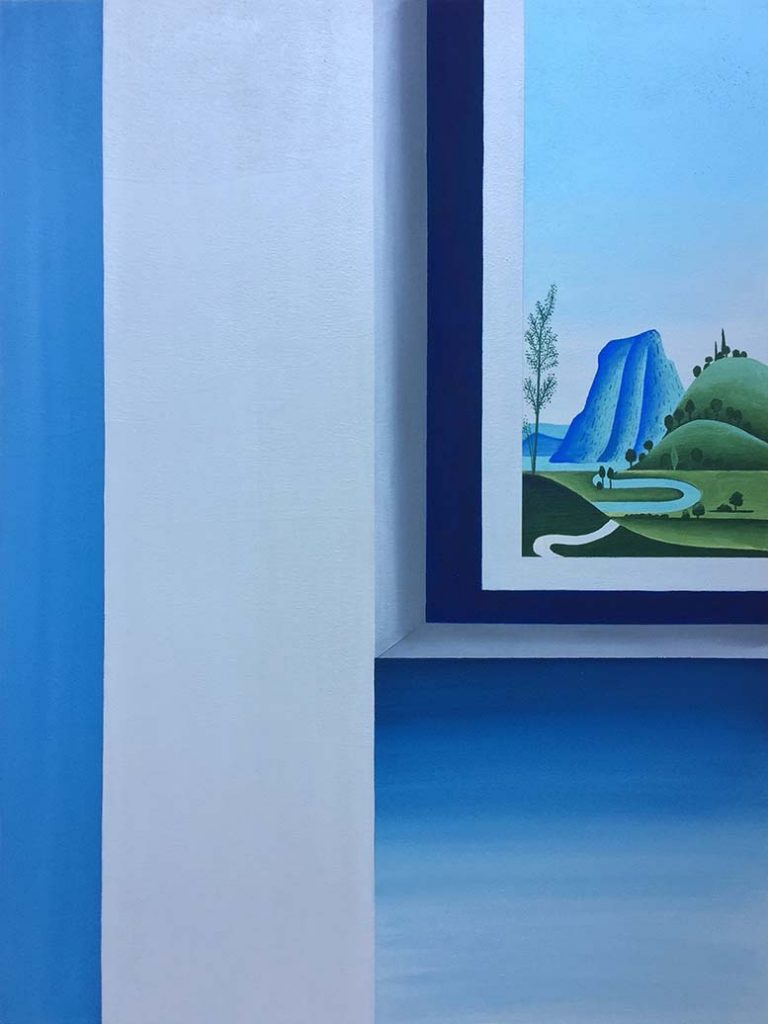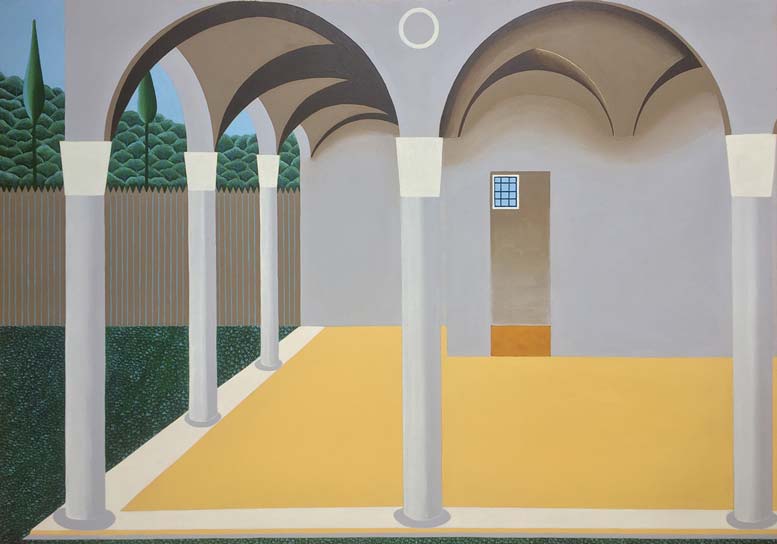French contemporary artist Claire Nicolet talks about the direction of evolution of her work as a young artist, in an artist interview with the Asian Curator.
“I’m obsessed with the idea of the coexistence of things; from the mundane to the spectacular, the ugly to the sublime. Everything is equally important. The way one sees things can transfigure everything.”
French contemporary artist Claire Nicolet

Artist interview
Please tell us a little about yourself, what brought you to the world of art and how did you start ?
When I was a child I played with Lego a lot, I liked to dress up and to draw, just like any other kid. The originality was that I would add smiles on every objects (clouds, doors, houses, rooftops, trees). In high school I was very much into art class; though I imagined a more classical career. I grew up with the idea that an artistic career was too risky, and that I needed a ‘real’ job. Then I studied humanities for a year, before enrolling in art school. I chose to study Graphic design thinking it was the best way to have a steady job. At some point I even studied advertising!
Thankfully, I had the opportunity to follow an engraving course in the same school. I was lucky to learn with artist Françoise Pétrovitch who was heading it. I greatly admired her and her very diverse work.
Engraving was very interesting as it required organisation. Different steps are required to create and print an image, like when you cook something. This diploma allowed me to enter the Paris Fine Arts School (Beaux-Arts de Paris). Working in Jean-Michel Alberola’s studio and feeling totally free in my approach, I continued my artistic research. Drawing with pencil colours and making wooden sculptures representing the city. I also created my first books with drawings, which I edited myself. I feared being alone after graduation, away from the school and its comfortable surroundings. But I realised that work was the best solution against future uncertainty and overwhelming doubt. I have always worked steadily, every day. It is this faith in my work which I think helped me get my first exhibitions and residencies.
What is the primary role of an artist? How do you describe yourself in the context of challenging people’s perspectives via your work and art?
My definition of the artist is very simple. He/She expresses very sincerely his/her intimate relationship to the world. An illumination or an idea generates a desire which will be given shape. Everything is possible. It is a poetic interpretation of a world in constant construction; another way to integrate what is real. A way to say, “Look around you, it is here if you learn how to see it.” My work cannot be separated from thought even if it doesn’t show immediately. It is the global underlying intellectual journey which contributes to the work; an invisible complexity hidden under seeming simplicity.
I’m obsessed with the idea of the coexistence of things; from the mundane to the spectacular, the ugly to the sublime. Everything is equally important. The way one sees things can transfigure everything.
There are rarely any humans in the images I create. Spaces empty from any human beings allow to grasp an environment fully, a feeling of the « being here » or « here and now » hic et nunc. What inhabits me is the research of an eternal present.
How do you deal with the conceptual difficulty and uncertainty of creating work?
It ties with what I was saying in the first question. Works gives balance. I’m constantly in doubt but movement allows to move forward. If I stop creating for a few days, doubt overwhelms me but next come very productive days. The most important thing is the journey (being lived).
What would you call your style? Lets talk about the evolution of your practice over the years. Tell us about your commitment to your current medium.
I am a young artist so I guess my work evolves and will change over time. A few years ago I was very into abstraction and approached art more conceptually. What I’ve done most so far is drawings. I only started painting two or three years ago. In 2017 I initiated a series entitled Topoï (places in ancient Greek), A4 drawings on paper. The collection draws inspiration from places I’ve observed, either imaginary or dreamed. I use a vocabulary of recurring shapes which have become a language: bricks, clouds, water, plants. Some parts are akin to map keys. In my creative process, the drawings become a speech. The bigger paintings are pauses, silence zones, with bright colours and deep blue skies.

What inspires you? Lets talk about your frameworks, references and process.
I draw inspiration in spaces first, from the streets to the immensity of the sky and ocean. In the city I like doors, windows, railings, rooftops, the empty and the full, and the in between ; all the architectural elements which shape the urban space, also when they are combined with plants, shadows and light. I catch light, cast shadows, color balances, and perspective. In nature I linger over skies, the sea, and trees. The daily Walking/Thinking exercice is key to my creative process. Ideas spring up from this movement which combines space and time.
As for artists, I take inspiration in the Italian Quattrocento, Georgia O’Keeffe and David Hockney’s paintings, Nabis painters, Japanese etchings/prints, and Chinese classical painting. Music and literature, especially novels, feed the work I am building; consciously or subconsciously.
What are you looking for when you look at other artists’ work? Which shows, performances and experiences have shaped your own creative process? Who are your maestros?
My interest in other artists works is aroused when I find vivid ideas and emotions met with beauty or grace. I’m impressed by artists whose practices have no limits and desire is insatiable : architects, sculptors, filmmakers, poets, drawers, painters etc. When you can find in each piece they produce their thinking process and energy. Thomas Schütte’s exhibition at Musée de la Monnaie in Paris, French artist and former professor Jean-Michel Alberola’s practice, and even the artist-engineer-architect Leonardo da Vinci’s works are good examples.
How does your interaction with a curator, gallery or client evolve from the initial interface, to the working-involvement-relationship?
I’m not represented by a gallery yet. I’ve built relationships with a few art collectors and curators I admire very much lately. What I enjoy most is showing them my work in the studio.
Think of the biggest professional risk you’ve taken. What helped you take that risk?
Last year I decided to quit my part-time job working in a restaurant and to devote myself to my artistic practice. I had sold a few paintings which allowed me to take that risk.

Any mentor, curator or gallerist who deserves a special mention for furthering your journey? What is the best piece of advice you’ve received?
In 2017, I was very lucky to meet Michel Nuridsany, an Art critic, curator, and writer. He is on the panel for the Prix Yishu 8 which offers a residency to young French artists in Beijing; and has helped highlight the work of many international artists. He is still looking out for new talents. Thanks to him I was able to do this residency and spend three months in China last year. These few weeks have been a milestone in my young career. I am very grateful to Christine Cayol who founded Yishu 8 . She is very dedicated to supporting emerging artists and consolidating French-Chinese relationships.
Tell us about your studio, what kind of place is it? Could you describe your usual work-day in the studio?
The studio is inside my apartment in Paris, in the 12th district, which is a very quiet and green neighborhood. When the window is open I can hear birds chirping, the wind in the trees, smell flowers. I live and work in one single room. Living amongst my paintings doesn’t bother me at all. I like to start working early in the morning, after I reading for an hour or so, and also at night. This would not be as easy if I had a studio outside. I try to work out before lunch and to go out at night often, and keep a balanced social life.
Are you more of a studio artist or naturally collaborative by nature? How do you feel about commissions?
I like to work alone. My artistic research is very solitary and I am not on the lookout for collaborations. However it happens that people contact me for special requests. I accept if it allows me to engage in new ideas/if it fosters/awakens new ideas, or if there is a clear/obvious connection to what I engage in/my practice/research.
What was your first sale? Do you outsource commercials or handle them yourself?
The first time piece I sold was at Under Construction Gallery in 2016. A drawing from « RTVA. Raconte Ta Vie Ailleurs », a journal I had been writing and drawing the previous winter. Since I’m not represented by a gallery yet, I handle sales myself except when a piece is part of a gallery show. Like I said, what I enjoy most is when people come to my studio and we can have a conversation.
What are you working on now? What’s coming next season?
An exhibition at Espace Larith, centre d’Art contemporain in Chambéry, Savoie, France.
Also a residency with Clermont-Ferrand’s architecture school for a commissionned research project on the practice of walking and territorial representations.
“I decided to remove all the characters and let landscapes take over, giving emphasis to the background, perspectives and symbolic spatial compositions which are often paramount to the works of this time.“
French contemporary artist Claire Nicolet
What were you working on when the lockdown was announced?
I was working on Renaissance paintings interpretations (a Fra Angelico Annunciation, Cranach’s Fountain of youth, and others). Since I’m very interested in spaces, I decided to remove all the characters and let landscapes take over, giving emphasis to the background, perspectives and symbolic spatial compositions which are often paramount to the works of this time. Strangely enough this idea to work on empty spaces came long before the pandemic, I had already done a few pieces last year but it took a whole other meaning with the current state of things.

How has this affected your practice and plans?
At first it didn’t, because I am used to working from home. Then quickly, being denied the sensitive world for a long period of time became very oppressive. I had a creative block and was short of ideas and desire for about ten days. I was also a bit disappointed because an exhibition of my work had started just a week before we were forced to go into lockdown. It has still not reopened.
What would elevate artists’ life during this period?
I must say I have read more artists interviews than ever. Indeed it is a good time to exchange and reflect. As for me, I’m not feeling very much part of the art system or the industry so I couldn’t tell, I think that galeries and fairs had great challenges to take up and ideas to find.
How did you balance life and work at home during this period?
Ideas and images from the outside were missing very much and I draw a lot from them in my work. It didn’t stop me from working hard on a lot of drawings and paintings I had in mind before it all started. Otherwise no major changes.
Before you go – you might like to browse our Artist Interviews. Interviews of artists and outliers on how to be an artist. Contemporary artists on the source of their creative inspiration.












Add Comment